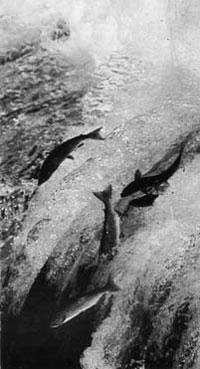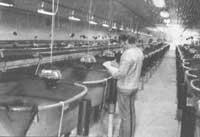What is the contribution of fish farms?
2000/07/04 Roa Zubia, Guillermo - Elhuyar Zientzia
In the world there are about 6.000 million inhabitants and that figure is increasing. Among other things, the consumption of fish is also much higher. To address this problem, it would be necessary to promote fish farming. However, the contribution of these nurseries is under discussion. Is the fish population increasing or decreasing, including fish farming? The journal Nature has published a general analysis of this problem.
In ten years, between 1987 and 1997, the production of fish farms has doubled. If production increases, consumption also increases. In fact, about a quarter of the fish eaten in the world is one of the fish farms. However, it is necessary to analyze the influence of these crops on ecosystems and marine resources.
Possible ecological condition
Some types of aquaculture, including shrimp and salmon, can damage coastal resources and reduce the number of marine fish. Another type of species, usually vegetarian species, are not harmful. Thus arises the paradox. Aquaculture can be a way to increase the number of fish, but it is also a factor of exhaustion of marine life.
Between free and farm fish is the competition for the supply of coastal ecosystems. They also have links or economic competition at the time of their market placement. It is a clear idea that is spreading in the current debate; the future of aquaculture will set the number of fish generated at sea.
Today more than 220 species grow in fish farms. When it comes to carrying the business, two main trends are observed, that of exploiting the property of fish without altering the natural cycles and that of participating in those cycles (such as livestock). In the latter, different behaviors are also produced. Some have a severe influence, eliminate predators from fish, control competition, etc. Others, for example, are responsible exclusively for the supply of food.
Molluscs, in general, grow on coasts. Their diet depends on plankton and organic particles provided by the sea. The most cultivated in the world are shrimp. For the growth of stripes many different methods are used. Marine fish usually grow in mesh cages. River flows often grow in artificial pools integrated into ecosystems close to agriculture.
In the last decade, approximately two types of companies have been created around fish farms. The first are large and grow animals of high added value for sale in large markets. They are usually nurseries of regional supply, but there are also large extensions. Another type are cooperatives and family businesses. They grow low-priced species and are sold in localized markets.
In fact, the dynamics of the markets of aquaculture fish vary greatly according to the species. The proliferation of fish farms can contribute to preserving natural reserves. In addition, if the prices of animals from different farms decrease, the money that enters the catch can be reduced considerably. Some species can replace others.
However, it does not occur with other species. For example, in the case of salmon, despite the proliferation of nurseries in recent years, catches have also increased. In fact, between 1997 and 1998 global catches have increased by 27%. Therefore, nurseries are not always substitutes for fishing.
Sustainable aquaculture
In general, it can be affirmed that the production of nurseries increases the number of fish in the world, although some types of aquaculture present a negative net contribution. This negative contribution comes from two types of aquaculture, which develops carnivorous species and destroys coastal ecosystems. Ecosystem degradation is due to biological pollution and untreated discharges.
But the extension of aquaculture will require healthy, both coastal and freshwater ecosystems. Until the environmental dependence of the industry is recognized, aquaculture cannot be developed in all its capacity. Scientists, therefore, have launched the following proposals when setting the priorities of fish farms: to increase fish aquaculture at a lower trophic level; to reduce the amount of meat and fish oil in food; to develop integrated farming systems; to spread and promote aquaculture habits for a healthy environment.

Gai honi buruzko eduki gehiago
Elhuyarrek garatutako teknologia






